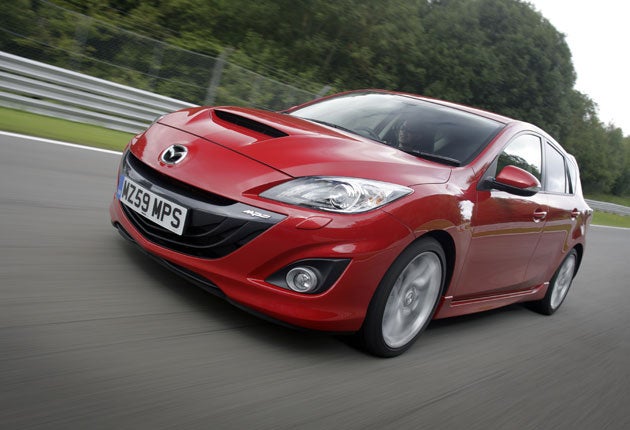Mazda 3 MPS
The original was awful. Now, it's back ... and this time it delivers

Speed is not enough. The first incarnation of the Mazda 3 MPS had plenty of that. With 260bhp ready to pour through its front wheels, it set a new land-speed record for an off-the-shelf hot hatchback while nudging the boundaries of tractive ability in a way only since exceeded by the current Ford Focus RS.
The Focus copes. The MPS did not. All the promise of that 2.3-litre, directly-injected, turbocharged motor was vaporised by stiff, sticky, springy steering. It was awful.
So the fact that the MPS could reach 62mph in 6.1 seconds and stay with every German übersaloon flat-out on the autobahn (an amusing trick in itself), counted for little when man and machine were in such disharmony. Add very low-key looks and the outcome was obvious. In the UK at least, the Mazda 3 MPS bombed.
That's a shame. Because for pace-per-pound-sterling the MPS was a hard act to beat. Now there's a new one, because the whole Mazda 3 range has been made over with a new nose, a new interior and a stiffer body structure. Virtually every external body panel is new, too, although you need to see a new Mazda 3 parked next to an old one to be sure.
A stiffer body structure is a very good thing when there are problems to be solved with the steering. But for the MPS, plenty of other details have changed, both visible (it now looks quite aggressive) and hidden. What follows might seem arcane to the non-enthusiast, but it's vital to the MPS's rehabilitation.
The steering rack has three mountings instead of two, the suspension subframes are stronger and the rubber bushes in the suspension are stiffer. The tyres, now with extra-stiff sidewalls, are mounted on hefty 18in wheels. The driveshafts are now designed so that each has the same resistance to twisting as the other, which should stop the former tendency to tug sideways on sudden acceleration. The front anti-roll bar's mounting points are nearer to the car's edges, so the bar has more favourable leverage and a more immediate effect. Even if you're not into the niceties of suspension design, you'll sense that the MPS should now steer like a go-kart (and maybe ride like a farm-cart).
Inevitably, given the technical explanation, the MPS feels unyielding over lumps and bumps. But it's not as bad as I expected, because the suspension is softer than before. Maybe more supple sidewalls in the tyres would create a compromise, but the MPS engineer, Shinichi Inata, wants to keep the new car's very positive steering feel around the straight-ahead position. It's a point of honour given the old car's hopelessness there.
Clearly, the engineers have taken past criticism to heart, and once the MPS is out on the open road the success of its reinvention shines through. The engine pulls with great vigour, once past a soft patch when asked to accelerate from low speeds, but then it always did. What's new is the feeling of flow and connectedness when stringing together a series of bends, and a sense of precision which reminds you that under a Mazda 3 is a design closely related to the Ford Focus.
For the MPS this does not extend to the "Revoknuckle", a clever device used in the Focus RS's front suspension which is the key to allowing the front wheels to steer properly while transmitting vast power. The MPS does it electronically instead, by reducing the pulling power sent to the wheels as the amount the wheels are steered is increased. The old MPS did this in first and second gears but, after discovering how wayward it could be on damp motorway sliproads in third gear, the engineers applied the system to third as well.
There's also an electronic version of a limited-slip differential, which uses individual front brakes as needed, and it all works subtly enough for you not to feel that you are being electronically over-managed. All this means the MPS does lack the ultimate physicality and intimacy of the Focus RS, but so does nearly every other car. And, at £21,500, it's a good deal cheaper. Rehabilitated? I should say so.
The Rivals
Ford Focus RS: £26,395.
Its 305bhp from a 2.5-litre turbo engine is a European record for front-wheel drive. Looks and sounds loud, is riotously entertaining to drive.
Subaru Impreza WRX-S: £22,025.
Cult status has worn thin with the new hatchback version, but flat-four engine and four-wheel drive are still intriguing. This version has 225bhp.
Volkswagen Golf GTI 5dr: £23,600.
The sensible choice. The latest Mk6 is more refined and has clever electronic differential, but though ultra-capable it's less fun than the last one.
Join our commenting forum
Join thought-provoking conversations, follow other Independent readers and see their replies
Comments
Bookmark popover
Removed from bookmarks